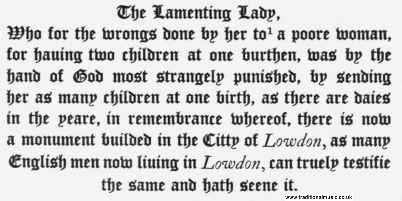A PEPYSIAN GARLAND - online book
Black-letter Broadside Ballads Of The years 1595-1639
| Share page | Visit Us On FB |
|
THE LAMENTING LADY |
||
|
Kittredge adds, is given in Sarah Hewett's Nummits and Crummits, Devonshire Customs, 1900, p. 19, and a better form in Bechstein's Volkssagen und Legenden des Kaiserstaates Oesterreich, 1841, No. 10, p. 121, and in Karl Reiser's Sagen, Gebrauche und Sprickworter des Allgaus, 1, 409-411.
Possibly there is a faint reference to the lamenting lady in King Lear, 11, iv, 54, where the Fool says: "Thou shalt have as many dolours for thy daughters as thou canst tell in a year." Compare also the remark of Robert Waring, in verses "To the Memory of his deceased Friend, Mr William Cartwright," prefixed to the 1651 edition of Cartwright's Comedies:
As the Dutch Lady, who at once did bear Numbers, not Births, to date each day i* th' year, Grew barren by Encrease; and after all, None could Her, Mother, or them Children, call. So whilst All write, None judge, we multiply So many Poems, and no Poetry.
Samuel Pepys himself was one of the Englishmen who had seen the basins and the inscription. In his Diary for May 19, 1660, Pepys notes that he went "by waggon to Lausdune, where the 365 children were born. We saw the hill where they say the house stood wherein the children were born. The basins wherein the male and female children were baptized do stand over a large table that hangs upon a wall, with the whole story of the thing in Dutch and Latin, beginning, 'Margarita Herman Comitissa,' &c. The thing was done about 200 years ago." See further Notes and Queries, 2nd S., vn, 260.
For the tune see Chappell's Popular Music, 1, 196. The date of the ballad may be assumed to be 1620.
 To the tune of the Ladies fall. 1 by her to: text to her by. |
||
|
124 |
||